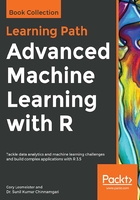
Descriptive statistics
Traditionally, we could use the base R summary() function to identify some basic statistics. Now, and recently I might add, I like to use the package sjmisc and its descr() function. It produces a more readable output, and you can assign that output to a dataframe. What works well is to create that dataframe, save it as a .csv, and explore it at your leisure. It automatically selects numeric features only. It also fits well with tidyverse so that you can incorporate dplyr functions such as group_by() and filter(). Here's an example in our case where we examine the descriptive stats for the infantry of the Confederate Army. The output will consist of the following:
- var: feature name
- type: integer
- n: number of observations
- NA.prc: percent of missing values
- mean
- sd: standard deviation
- se: standard error
- md: median
- trimmed: trimmed mean
- range
- skew
gettysburg %>%
dplyr::filter(army == "Confederate" & type == "Infantry") %>%
sjmisc::descr() -> descr_stats
readr::write_csv(descr_stats, 'descr_stats.csv')
The following is abbreviated output from the preceding code saved to a spreadsheet:

In this one table, we can discern some rather interesting tidbits. In particular is the percent of missing values per feature. If you modify the precious code to examine the Union Army, you'll find that there're no missing values. The reason the usurpers from the South had missing values is based on a couple of factors; either shoddy staff work in compiling the numbers on July 3rd or the records were lost over the years. Note that, for the number of men captured, if you remove the missing value, all other values are zero, so we could just replace the missing value with it. The Rebels did not report troops as captured, but rather as missing, in contrast with the Union.
Once you feel comfortable with the descriptive statistics, move on to exploring the categorical features in the next section.